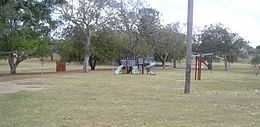Musgrave Park, Brisbane

Musgrave Park is a park in South Brisbane, a suburb of Brisbane, the capital city of the Australian state of Queensland. Musgrave Park is nestled between Edmonstone, Russell and Cordelia Streets and is approximately 3,000m2. The park is next to Brisbane State High School and Musgrave Park Pool. The park is of cultural significance to indigenous Australians.
History
Musgrave Park is a remnant of the former Kurilpa (South Brisbane) Aboriginal camping ground that stretched from “Highgate Hill and on (to) the slanting slopes of Cumboomeya (= Somerville House)” and additionally “sometimes they made a camp in the little scrub then situated on the river bank near the recent entrance to the Dry Dock”.[1] From here and Woolloongabba, Aborigines in the 1840s and 1850s would go into South Brisbane to work chopping wood, carrying water, and selling fish.[2]
The South Brisbane Recreation Reserve (as it was originally known) was created in 1856.[3]
In 1867, it was proposed to build a public grammar school (Brisbane State High School) adjacent to the reserve.[4]
In 1998, the Brisbane City Council allocated part of the park for the establishment of an indigenous cultural centre.[5] The council has described the park as a place for holding feasts, ceremonies and dispute resolution.[6]
Current use
Musgrave Park is home to the Jagera Arts Centre and is one of the few remaining green spaces left in Brisbane's inner city. On 24 August 1998, after twenty years of legal struggles with the Queensland state government, the Musgrave Park Aboriginal Corporation (MPAC) secured a lease to build a cultural centre on portions of the park.[7] The park holds special significance to the local indigenous population due to a past restriction barring Aborigines from crossing the park and entering the city of Brisbane[citation needed]. Notably, being the site of a buried bora ring, it has historically been a sacred site to the native Murri people.
Each year, the park hosts the Paniyiri Greek Festival, the National Aboriginal and Islander Day of Celebration (NAIDOC) Park Day, and the Lesbian and Gay Brisbane Pride Festival Fair Day.
Crime

In 2008 a man was beaten to death at Musgrave Park.[8] This incident has added to the perception that Musgrave Park is dangerous. However statistics from 2007-2010 show that incidents of assault are concentrated around the foreshore and train stations of South Bank, and the main venues on Boundary street in West End, with relatively few incidents occurring in Musgrave Park.[9]
In 2009, the park was temporarily closed while the Brisbane city council performed tests regarding the land surveying of the immediate area. During these tests, a number of city council staff were assaulted by heavily intoxicated persons.[citation needed] There have been continued confrontations between police, council workers and park residents.[citation needed]
See also
References
- ↑ (Chas Melton, ‘When Wolloongabba was Wattle-scented,’ 20 March 1915, pp.58-59 of Melton Cuttings Book, RQHS).
- ↑ CLARK W. A JUBILEE RETROSPECT.—THE CITY OF SOUTH BRISBANE. The Queenslander (Brisbane) Saturday 7 August 1909 Page 21).
- ↑ "South Brisbane". Queensland Places. University of Queensland. Retrieved 9 August 2011.
- ↑ "PUBLIC GRAMMAR SCHOOL—A SUGGESTION.". The Brisbane Courier (Qld. : 1864 - 1933) (Qld.: National Library of Australia). 28 October 1867. p. 3. Retrieved 9 August 2011.
- ↑ Tony Moore (16 May 2012). "Lord Mayor to meet with Aboriginal elders over park future". Brisbane Times (Fairfax Media). Retrieved 16 May 2012.
- ↑ "Musgrave Park Cultural Centre". Brisbane's Living Heritage Network. Retrieved 16 May 2012.
- ↑ FAIRA: Historic handover at Musgrave Park
- ↑ Amelia Bentley (22 October 2010). "Teen given life sentence for Musgrave Park murder". Brisbane Times (Fairfax Media). Retrieved 18 May 2012.
- ↑ "Brisbane Central crime hot spots". couriermail.com.au (News Queensland). Retrieved 18 May 2012.
External links
- Musgrave Park Cultural Centre
- The Foundation for Aboriginal and Islander Research Action (FAIRA)
- The Brisbane Pride Festival
Coordinates: 27°28′44″S 153°01′00″E / 27.4790°S 153.0166°E